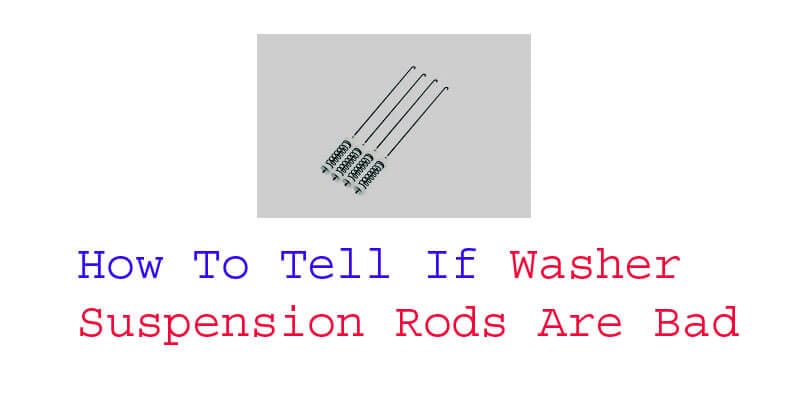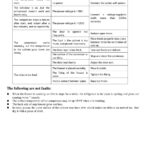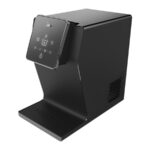To determine if washer suspension rods are bad, check for suspended tub movement and unusual noises during spinning. Replacing damaged rods and suspension springs will ensure the proper functioning of the washing machine.
Washer suspension rods play a crucial role in a washing machine’s balance. When these metal rods wear out or break, they can cause serious problems with the machine. If left untreated, this can lead to uncontrollable bouncing, shaking, and water leaks.
Homeowners can easily identify damaged rods by observing any out-of-balance movement of the wash drum or unusual noises during a washing cycle. It is important to replace damaged rods or suspension springs immediately, as they are integral to the safe and efficient functioning of the machine. With proper maintenance and care, homeowners can extend the life of their washing machine and avoid costly repairs.

Unusual Vibrations During Washing Cycles
Understanding Unusual Vibrations During Washing Cycles
Washing machines have suspension rods that secure the tub to the frame of the machine, allowing it to operate seamlessly during a wash cycle. However, these suspension rods can deteriorate over time, causing the tub to bounce, vibrate, or move excessively.
If you notice these unusual vibrations during a wash cycle, it is an indication that the suspension rods may be worn out and require replacement.
Types Of Vibrations And Diagnosis
The different types of vibrations that you may experience during a wash cycle include:
- Horizontal or sideways shaking
- Front-to-back movement
- Vertical bouncing or jumping
Diagnosing the issue can assist in determining the specific suspension rods that require replacement. For example, horizontal or sideways shaking may indicate a problem with the tub’s lateral suspension rods, while front-to-back movement points to the tub’s longitudinal rods. Vertical bouncing, on the other hand, occurs due to faulty shock absorbers.
Tips For Addressing Unusual Vibrations
If you notice unusual vibrations during a wash cycle, here are some tips to assist you in addressing the issue:
- Check that your machine is level; misaligned machines can shake and move during use, even if the suspension rods are still functioning well. Check that the machine is level with a carpenter’s level, and adjust the leveling feet accordingly.
- Load clothes evenly – overloading or underloading the machine can cause the tub to move unnaturally. It is advisable to load clothes evenly in the machine.
- Check the suspension rods. Inspect the rods carefully for any wear and tear and replace them if they appear worn or damaged. Refer to your machine’s manual for instructions on how to remove and install the rods.
- Maintain the machine: regular machine maintenance can keep the suspension rods and other related components functioning optimally. Consider cleaning the machine’s drum, checking hoses, and ensuring that the load size is appropriate.
Knowing how to identify and address unusual vibrations during a wash cycle can aid in maintaining your washing machine’s performance and prolonging its lifespan. Always remember to follow the above tips to keep the suspension rods in good working condition.
High-Pitched Or Unusual Noises During Washing Cycles
Discuss How Failing Suspension Rods Can Cause Unusual And High-Pitched Noises During A Wash Cycle.
Suspension rods are critical components in washing machines that support the tub’s weight and dampen vibrations during a wash cycle. However, these rods may not last forever and wear out eventually, causing problems such as unusual noises during a wash cycle.
Explain The Different Types Of Noises That Can Occur And How They Can Help Diagnose The Issue.
When a washing machine’s suspension rods start to fail, it manifests as several different types of noises during a wash cycle. Here are some of the notable examples:
- High-pitched squeaking or whining noises: This type of noise is often indicative of worn-out bearings or bushings between the suspension rods and the tub.
- Banging or thumping noises: If you hear loud banging or thumping during the spin cycle, it may indicate that one or more suspension rods are bent or broken, allowing the tub to rattle and hit against the washer.
- Grinding or rubbing sounds: Such noises often indicate that the suspension rods’ rubber bushings have worn out, allowing the metal parts to grind together.
Provide Tips On What The User Can Do If They Notice Unusual Noises During A Wash Cycle.
Knowing that failing suspension rods are often the cause of any unusual noises in the washing machine can help you diagnose and fix the problem quickly. Here are some tips to help you out:
- Stop the washing machine immediately if you hear any strange noises during the wash cycle. Do not attempt to run it since you could cause more damage.
- Inspect the suspension rods and springs for any signs of damage or wear, and replace any parts as necessary.
- Check whether the washing machine is level and properly balanced. Failure to do so may cause suspension rods to wear out more quickly.
- Use a high-quality suspension rod if you need to replace any of them. A genuine part will last longer and perform better than a cheap knock-off.
- Finally, if you still can’t identify or fix the problem, it’s best to call a professional washing machine repair service to help you out.
Unbalanced Washer Drum
How Failing Suspension Rods Can Cause The Washer Drum To Become Unbalanced During A Wash Cycle
If you’ve been doing laundry for some time, you may have noticed that sometimes, during the wash cycle, your washer drum seems to be going crazy, banging loudly against the sides of the machine. This is a sign that something’s not right, and in most cases, it’s the suspension rods.
The suspension rods connect the drum to the frame of the machine and keep the washer drum stable during the wash cycle. When they wear out, they can allow the drum to become unbalanced, leading to loud noises and a shaky machine.
Here are some of the ways that failing suspension rods can cause the washer drum to become unbalanced during a wash cycle:
- Worn-out rubber grommets: The rubber grommets on the suspension rods help to absorb vibrations and prevent the drum from moving around too much. When they wear out, the drum can move more freely, leading to an unbalanced load.
- Weak suspension springs: The suspension springs help to keep the drum level stable during the wash cycle. When they wear out or weaken, the drum can start moving more than it should, which can lead to an unbalanced load.
- Damaged suspension rods: Over time, the suspension rods can become damaged from wear and tear or from overuse. When this happens, they can’t support the weight of the drum the way they’re supposed to, and the drum can become unbalanced.
The Dangers Of Using An Unbalanced Washer Drum And How It Can Lead To Long-Term Damage
An unbalanced washer drum might not seem like a big deal, but it can actually lead to some serious problems over time. Here are some of the dangers of using an unbalanced washer drum:
- Wear and tear on the drum: When the drum is unbalanced, it can cause unnecessary wear and tear on the machine. The drum can become dented or warped, which can lead to further problems down the line.
- Damage to the motor: The motor is responsible for powering the machine and keeping everything running smoothly. When the drum is unbalanced, it can put extra strain on the motor, which can cause it to burn out sooner than it should.
- Noise pollution: An unbalanced washer drum can be incredibly loud, which can be a nuisance for you and your family. It can also be irritating to your neighbors if you live in an apartment or a townhouse.
Tips On What The User Can Do If They Notice An Unbalanced Washer Drum
If you notice that your washer drum is unbalanced, don’t panic. There are a few things you can do to fix the problem:
- Check the suspension rods: If the suspension rods are worn out or damaged, you’ll need to replace them. You can find replacement rods online or at your local appliance repair store.
- Level the machine: Make sure that your washing machine is level. You can use a level to check the machine and adjust the feet as needed.
- Adjust the load: Sometimes, an unbalanced drum is caused by an uneven load. Make sure that you’re distributing your laundry evenly around the drum and that you’re not overloading the machine.
- Avoid overloading: Don’t overload your washing machine, as it can cause serious issues. Follow the manufacturer’s recommendations for load size and weight.
By following these tips, you can keep your washing machine running smoothly and avoid any long-term damage caused by an unbalanced drum. Remember to always check the suspension rods to prevent these problems from occurring.
Increased Wear And Tear On Other Washer Parts
Failing suspension rods can wreak havoc on other washer parts, causing them to wear out faster than normal. This can lead to a host of laundry-related problems and eventually costly repairs. Here are some of the ways that deteriorating suspension rods can contribute to increased wear and tear on your washer’s components:
- Tub bearings: Faulty suspension rods can put additional strain on the tub bearings, which support the wash drum. When the bearings are subjected to too much stress, they can become noisy, vibrate excessively, or even fail, causing the drum to stop spinning altogether.
- Drive belt: A malfunctioning suspension system can also place extra pressure on the drive belt that turns the drum. This can cause it to slip, stretch, or even snap prematurely, resulting in a washer that won’t spin or agitate.
- Shock absorbers: Suspension rods usually work in tandem with shock absorbers to minimize vibration and noise during a wash cycle. When the rods lose their ability to cushion the drum properly, an increased amount of force is put on the shock absorbers, causing them to wear out more quickly. This can lead to excess noise and a bouncy washer.
Ignoring the issue of bad suspension rods can lead to expensive, complex repairs that could have easily been avoided. Plus, regular maintenance will save you money in the long run by extending the life of your washer and preventing the need for pricey replacements and repairs.
It’s essential to stay on top of your appliance’s health and to address any problems as soon as they arise.
Frequently Asked Questions
What Are Washer Suspension Rods?
Washer suspension rods are part of the washing machine’s structure that helps it absorb shock.
What Are The Signs Of Bad Suspension Rods?
Signs of bad suspension rods include excessive shaking during the wash cycle and uneven loads.
How Do Bad Washer Suspension Rods Affect My Machine?
Bad suspension rods can put additional stress on the machine’s motor and cause damage to the drum.
Can I Replace Washer Suspension Rods Myself?
Yes, you can replace washer suspension rods yourself by following the manufacturer’s instructions.
How Do I Know If I Need To Replace Suspension Rods?
You may need to replace suspension rods if your washing machine is excessively shaking or making strange noises.
More Troubleshooting Guide
GE DISHWASHER NOT STARTING BEEPS 3 TIMES 2:TROUBLESHOOT GUIDE
Conclusion
To sum up, the washer suspension rods play an essential role in keeping your washing machine stable and functioning well. If you notice any of the signs we discussed in this post, it’s important to address the issue as soon as possible to avoid further damage to the machine.
Remember to inspect the suspension rods regularly and replace them immediately if you notice any signs of wear and tear. Doing this can save you from costly repairs down the line and make your washer last longer. We hope this guide has helped you identify the signs of bad washer suspension rods and provided you with the information you need to keep your washing machine in top-notch condition.




